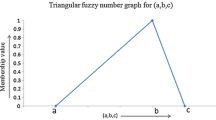Abstract
Typically in DEA, all the DEA parameters are considered as crisp values. However, in the physical world, input-output data can be imprecise or vague. This type of imprecise data can be represented pleasantly by fuzzy numbers. Researchers used input-output data as fuzzy values in fuzzy DEA (FDEA) models, whereas weights (decision variables) associated with these input-output data were crisp. However, in the physical world, weights can also take the form of fuzzy numbers. To overcome this shortcoming of FDEA models, fully fuzzified DEA (FFDEA) models are introduced where all input-output data and weights are considered fuzzy values. We extended FDEA to FFDEA in which all variables along with input-output data are fuzzy numbers, in particular, triangular fuzzy numbers (TFNs). With the help of the \( \alpha - {\text{cut}} \) approach, we developed left and right-hand efficiency models for measuring the relative performance of each DMU and rank them according to their efficiencies. Finally, the developed FFDEA model is compared with existing approaches with the help of an example; and a real-life application of developed FFDEA model in the education sector is presented.

Similar content being viewed by others
References
Cooper, W. W., Seiford, L., Tone, K.: Data envelopment analysis: theory, methodology, and applications, references and dea-solver software. (2000)
ScholaroPro, Education system in India. (2021). https://www.scholaro.com/pro/Countries/India/Education-System
Tyagi, P., Yadav, S.P., Singh, S.: Relative performance of academic departments using DEA with sensitivity analysis. Eval. Program Plan. 32(2), 168–177 (2009)
Yang, G.-L., Fukuyama, H., Song, Y.-Y.: Measuring the inefficiency of Chinese research universities based on a two-stage network DEA model. J. Informetr. 12(1), 10–30 (2018)
Türkan, S., Özel, G.: Efficiency of state universities in turkey during the 2014–2015 academic year and determination of factors affecting efficiency. Egitim ve Bilim, 42(191) (2017)
Chen, J.-K., Chen, I.-S.: Inno-qual efficiency of higher education: empirical testing using data envelopment analysis. Expert Syst. Appl. 38(3), 1823–1834 (2011)
Eckles, J.E.: Evaluating the efficiency of top liberal arts colleges. Res. High. Educ. 51(3), 266–293 (2010)
Kantabutra, S., Tang, J.C.: Efficiency analysis of public universities in Thailand. Tert. Educ. Manag. 16(1), 15–33 (2010)
Tomkins, C., Green, R.: An experiment in the use of data envelopment analysis for evaluating the efficiency of UK university departments of accounting. Financ. Account. Manag. 4(2), 147–164 (1988)
Halaskova, M., Gavurova, B., Kocisova, K.: Research and development efficiency in public and private sectors: an empirical analysis of eu countries by using dea methodology. Sustainability 12(17), 7050 (2020)
Arcelus, F., Coleman, D.: An efficiency review of university departments. Int. J. Syst. Sci. 28(7), 721–729 (1997)
Sinuany-Stern, Z., Mehrez, A., Barboy, A.: Academic departments efficiency via DEA. Comput. Oper. Res. 21(5), 543–556 (1994)
Bessent, A., Bessent, W., Kennington, J., Reagan, B.: An application of mathematical programming to assess productivity in the Houston independent school district. Manag. Sci. 28(12), 1355–1367 (1982)
Hatami-Marbini, A., Emrouznejad, A., Tavana, M.: A taxonomy and review of the fuzzy data envelopment analysis literature: two decades in the making. Eur. J. Oper. Res. 214(3), 457–472 (2011)
Arya, A., Yadav, S.P.: Development of fdea models to measure the performance efficiencies of dmus. Int. J. Fuzzy Syst. 20(1), 163–173 (2018)
Kao, C., Liu, S.-T.: Fuzzy efficiency measures in data envelopment analysis. Fuzzy Sets Syst. 113(3), 427–437 (2000)
Wen, M., You, C., Kang, R.: A new ranking method to fuzzy data envelopment analysis. Comput. Math. Appl. 59(11), 3398–3404 (2010)
Guo, P., Tanaka, H.: Fuzzy dea: a perceptual evaluation method. Fuzzy Sets Syst. 119(1), 149–160 (2001)
Hatami-Marbini, A., Tavana, M., Ebrahimi, A.: A fully fuzzified data envelopment analysis model. Int. J. Inform. Decis. Sci. 3(3), 252–264 (2011)
Puri, J., Yadav, S.P.: A fully fuzzy dea approach for cost and revenue efficiency measurements in the presence of undesirable outputs and its application to the banking sector in india. Int. J. Fuzzy Syst. 18(2), 212–226 (2016)
Kazemi, M., Alimi, A.: A fully fuzzy approach to data envelopment analysis. J. Math. Comput. Sci 11, 238–245 (2014)
Sotoudeh-Anvari, A., Najafi, E., Sadi-Nezhad, S.: A new data envelopment analysis in fully fuzzy environment on the base of the degree of certainty of information. J. Intell. Fuzzy Syst. 30(6), 3131–3142 (2016)
Namakin, A., Najafi, S.E., Fallah, M., Javadi, M.: A new evaluation for solving the fully fuzzy data envelopment analysis with z-numbers. Symmetry 10(9), 384 (2018)
Zimmermann, H.-J.: Fuzzy set theory-and its applications. Springer Science & Business Media (2011)
Wang, Y.-M., Luo, Y., Liang, L.: Fuzzy data envelopment analysis based upon fuzzy arithmetic with an application to performance assessment of manufacturing enterprises. Expert Syst. Appl. 36(3), 5205–5211 (2009)
Wang, Y.-M., Chin, K.-S., Yang, J.-B.: Measuring the performances of decision-making units using geometric average efficiency. J. Oper. Res. Soc. 58(7), 929–937 (2007)
Acknowledgements
The authors wish to express their sincere thanks to the anonymous reviewers for their insightful comments which have significantly improved the quality of the work. We also express our gratitude to the Editor-in-Chief and Associate Editor for coordinating the entire process and ensuring the timely reviews. This study was funded by The Ministry of Education, the Govt. of India, with Grant number MHR01-23-200-428.
Author information
Authors and Affiliations
Corresponding author
Rights and permissions
About this article
Cite this article
Singh, A.P., Yadav, S.P. Development of FFDEA Models to Measure the Performance Efficiencies of DMUs. Int. J. Fuzzy Syst. 24, 1446–1454 (2022). https://doi.org/10.1007/s40815-021-01200-z
Received:
Revised:
Accepted:
Published:
Issue Date:
DOI: https://doi.org/10.1007/s40815-021-01200-z




